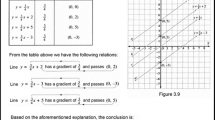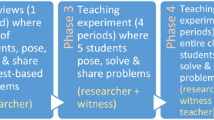Abstract
Learner-control strategies for selecting problem context and the level of instructional support were examined separately and in combination on a computer-based mathematics unit on the metric system. Subjects were 240 sixth-grade students assigned to 15 treatments formed by crossing five context conditions (animals, sports, clothing, nocontext, and learner control) with three instructional support conditions (minimum, maximum, and learner control). As hypothesized, comparisons of instructional support conditions on posttest achievement showed performance to be lowest under learner control. Subjects opted to view very few items and to decrease the amount they selected over the course of the instruction. No effects were associated with the context variable, although on one of the three lessons, learner-control subjects made significantly fewer on-task errors than did no-context subjects. Further analyses showed a strong tendency by learner-control context subjects to vary their selection of contexts across lessons. Subjects in the context and instructional support learner-control strategies indicated positive attitudes toward the strategies.
Similar content being viewed by others
References
Anand, P., & Ross, S. M. (1987). Using computer-assisted instruction to personalize math learning materials for elementary school children.Journal of Educational Psychology, 79, 72–77.
Bracken, B. (1982). Effect of personalized computer-based stories on the reading comprehension of fourth-grade poor and average readers.Contemporary Educational Psychology, 7, 320–324.
Carrier, C. A., Davidson, G., & Williams, M. (1985). The selection of instructional options in a computer-based coordinate concept lesson.Educational Communication and Technology Journal, 33, 199–212.
Carrier, C. A., & Sales, G. C. (1987). Pair versus individual work on the acquisition of concepts in a computer-based instructional lesson.Journal of Computer-Based Instruction, 14, 11–17.
Davis-Dorsey, J., Ross, S. M., & Morrison, G. R. (1991). The role of rewording and context personalization in the solving of mathematics word problems.Journal of Educational Psychology, 83, 61–68.
Gay, G. (1986). Interaction of learner control and prior understanding in computer-assisted video instruction.Journal of Educational Psychology, 78, 225–227.
Hooper, S., & Hannafin, M. J. (1991). Psychological perspectives on emerging instructional technologies: A critical analysis.Educational Psychologist, 26, 69–95.
Judd, W. A., Bunderson, C. V., & Bessent, E. W. (1970).An investigation of the effects of learner control in computer-assisted instruction prerequisite mathematics. (MATHS Tech. Rep. 5). Austin, TX: University of Texas. (ERIC Document Reproduction Service No. ED 053 532)
Lopez, C. L., & Sullivan, H. J. (1991). Effects of personalizing math instruction for Hispanic students.Contemporary Educational Psychology, 16, 95–100.
Murphy, L. O., & Ross, S. M. (1990). Protagonist gender as a design variable in adapting mathematics story problems to learner interests.Educational Technology Research and Development, 38, 27–36.
Reiser, R. A. (1984). Reducing student procrastination in a personalized system of instruction course.Educational Communication and Technology Journal, 32, 41–49.
Ross, S. M. (1983). Increasing the meaningfulness of quantitative material by adapting context to student background.Journal of Educational Psychology, 75, 519–529.
Ross, S. M., & Anand, P. (1987). Computer-based strategy for personalizing verbal problems in teaching mathematics.Educational Communication and Technology Journal, 35, 151–162.
Ross, S. M., McCormick, D., & Krisak, N. (1986). Adapting the thematic context of mathematical problems to student interests: Individual versus group-based strategies.Journal of Educational Research, 79, 245–252.
Ross, S. M., & Morrison, G. R. (1989). In search of a happy medium in instructional technology research: Issues concerning external validity, media replications, and learner control.Educational Technology Research and Development, 37(1), 19–33.
Ross, S. M., Morrison, G. R., & O'Dell, J. (1988). Obtaining more out of less text in CBI: Effects of varied text density levels as a function of learner characteristics and control strategy.Educational Communication and Technology Journal, 36, 131–142.
Ross, S. M., Morrison, G. R., & O'Dell, J. (1989). Uses and effects of learner control of context and instructional support in computer-based instruction.Educational Technology Research and Development, 37(4), 29–39.
Ross, S. M., & Rakow, E. A. (1981). Learner control versus program control as adaptive strategies for selection of instructional support on math rules.Journal of Educational Psychology, 73, 745–753.
Ross, S. M., & Rakow, E. A. (1982). Adaptive instructional strategies for teaching rules in mathematics.Educational Communication and Technology Journal, 30, 67–74.
Seidel, R. J. (1975).Learner control of instructional sequencing within an adaptive tutorial CAI environment. Alexandria, VA: Human Resources Research Organization Technical Report, 75–77.
Seidel, R. J., & Wagner, T. (1978). Learner control of instructional sequencing within an adaptive tutorial CAI environment.Instructional Science, 7, 37–80.
Tennyson, R. D. (1980). Instructional control strategies and content structure as design variables in concept acquisition using computer-based instruction.Journal of Educational Psychology, 72, 525–532.
Tennyson, R. D., & Buttrey, T. (1980). Advisement and management strategies as design variables in computer-assisted instruction.Educational Communication and Technology Journal, 28, 169–176.
Tennyson, R. D., & Rothen, W. (1977). Pretask and on-task adaptive design strategies for selecting number of instances in concept acquisition.Journal of Educational Psychology, 5, 126–134.
Whitener, E. M. (1989). A meta-analytic review of the effect on learning of the interaction between prior achievement and instructional support.Review of Educational Research, 59, 65–87.
Author information
Authors and Affiliations
Rights and permissions
About this article
Cite this article
Morrison, G.R., Ross, S.M. & Baldwin, W. Learner control of context and instructional support in learning elementary school mathematics. ETR&D 40, 5–13 (1992). https://doi.org/10.1007/BF02296701
Issue Date:
DOI: https://doi.org/10.1007/BF02296701




